| Dieses Spindler & Hoyer 6x24 Monokular wurde jeweils in einer 350 Stückzahl 1933 und 1935 von der Dänischen Armee importiert, nachdem die ersten 20 Probeexemplare, Modell Spindler & Hoyer 6x24 mit HT Kennzeichnung, beim Dänischen Militär Zustimmung fanden (vgl. a. S&H 6x24 (Sw. Armee). Der obere Deckel ist mit dem S&H-Logo, "6x24" sowie der Seriennummer 93972 gekennzeichnet. Der untere Deckel ist mit der "Dänischen Krone" und darunter den Buchstaben "HV" für Hærens Våbenarsenal (= Armee Waffenarsenal). Weiterhin hat das Dänische Militär folgende Beschriftung angebracht: E.P. 6x M.1933 Nr. 558 (= Enkelt Prismekikkert, 6x Modell 1933, Nr. 558 [Jahreszahl und Militränummer]). Das Monokular stammt also aus der zweiten Bestellung von 1935 (alle Gläser wurden mit Modell 1933 markiert). Vgl. hierzu M. Simonsen: Hærens Håndkikkerter, in Vabenhistoriske Aarborger 2004, S. 75ff. und S. 98. |
This Spindler & Hoyer 6x24 monocular was imported in two 350 piece batches in 1933 and 1935 by the Danish Army after the first 20 samples, Spindler & Hoyer 6x24 models with HT marking, were tested and accepted by the Danish military (vgl. S&H 6x24 (Sw. Army). The top cover plate is marked with the S&H logo as well as "6x24" and serial number 93972. The bottom cover plate bears the "Danish Crown" and below letters "HV" which stand for 'Hærens Våbenarsenal' (= Army Weapons Arsenal). Furthermore, the Danish military put the following inscriptions on the cover : E.P. 6x M.1933 Nr. 558 (= Enkelt Prismekikkert, 6x Model 1933, Nr. 558 [year and military number]). The monocular thus dates from the second batch of 1935 (all monoculars were being marked Model 1933). Cf. M. Simonsen: Hærens Håndkikkerter, in Vabenhistoriske Aarborger 2004, p. 75ff. and p. 98. |
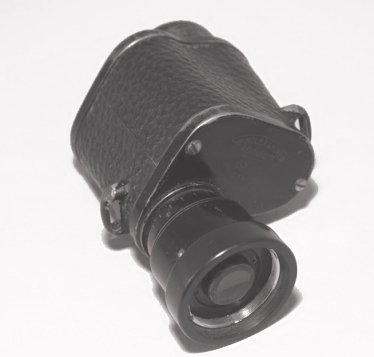
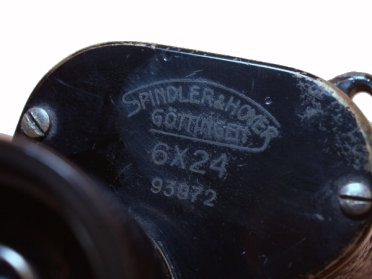
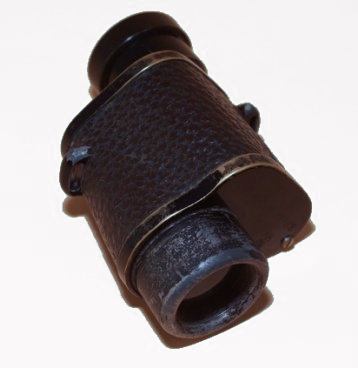
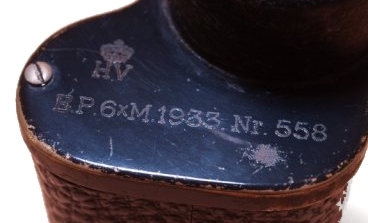
| Als Besonderheit darf jeweils eine Trageriemenöse an den gegenüberliegenden Gehäuseseiten gelten. Außerdem sind die Augenmuschel für Gasmaskenbenutzung flach. Die Messing-Okulare haben eine Drehfokussierung, sind aber ohne Riffelung oder Dioptrienskala. Es gibt eine Referenzlinie am unteren Okularstück, aber nicht am Fokussierungsteil. Die Messingdeckel sind oben zweifach, unten einfach veschraubt. Die Objektivfassung ist aus Aluminium. Im Okular befindet sich eine Strichplatte mit mittig positionierten, vertikalen eingeteilten Strichen in 5er und 10er Schritten, beschriftet von links nach rechts mit 0, 20, 40, 60 und 80. In der Mitte bei 40 ist eine kurze horizontale Linie, die so ein Fadenkreuz mit der vertikalen bildet. Das Spindler & Hoyer Monokular hat eine Länge von 96 mm bis 104 mm, ist am Gehäuse oben 49x49 mm und unten 54x54 mm breit. Die Objektivfassung ist 33 mm, das Okularstück 24 mm, der glatte Fokussierungsteil 31 mm und die Augenmuschel 35,5 mm im Durchmesser. Das Glas und wiegt 274 (Erstserie) bzw. 277g (Zweitserie). |
A special feature is the two strap lugs at the opposite sides of the body. Moreover, all eyecups are flat for gas-mask use. The left-hand sided brass eyepieces can be rotated for focusing, but do not have any knurling or dioptre scale. There is a reference line on th elöower eyepiece, but not on the focusing part. The top brass covers have two screws, the bottome ones have only one. The objective frame is amde of aluminium. The ocular system has a reticle with centred vertical division lines in steps of 5 and 10 from left to right inscribed with 0, 20, 40, 60 and 80. At divison line 40 in the middle, a short horizontal line crosses the vertical line, thus forming a cross-hairs. The Spindler & Hoyer monocular is 96 mm to 104 mm long, the housing measures 49x49 mm at its top and 54x54 mm at its bottom. The objective frame is 33 mm, the eyepiece 24 mm, the smooth focusing piece 31 mm, and the eyecup 35.5 mm in diameter. The glass weighs 274 (1st series) or 277g (2nd series). |
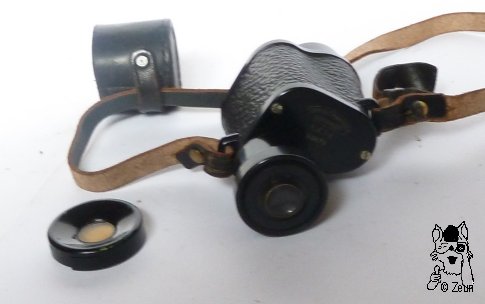
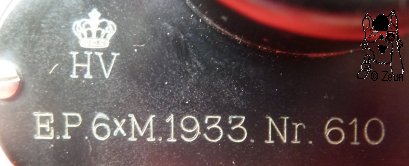
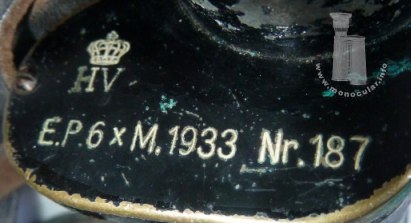
| Weitere abgebildete Exemplare sind aus der ersten gelieferten Serie mit Seriennummern 83545 und Militärnummer 187 bzw. aus der 2. Serie ein Exemplar mit Nummern 93678 bzw. 610. Die Modelle der 1. Serie sind lederummantelt, die der 2. mit Hartgummi; auch der Schrifttyp wechselt wohl von serifenloser zu Serifenschrift. Die oben angegebenen Maße sind für beide Serien gleich. Das Monokular Nr. 610 ist mit dem Originallederriemen mit Anknöpflasche, der Lederschutzkappe und den orangen Filter (verstaut im Köcherdeckel innen) ausgestattet. Die Köcher sind mit dem Emblem "HV" gestempelt. Der vorliegende von Nr. 187 erscheint etwas überdimensioniert. |
Other depicted models date from the first batch with the serial number 83545 and military number 187 as well as from the second batch with the serial number 93678, military number 610. Models from the first batch are leather covered, those from the second batch are coveed with hard rubber. Furthermore, the font used for the engravings seemingly changes from a sans serif to a serif font. Otherwies, all measurements given above are identical. Model #610 comes with its original leather strap and button flap, a protection leather cap for the eyepiece and an orange filter glass, stored in a compartment inside of the case lid. The cases are stamped with the "HV" mark. The one of No. 187 seems to be somewhat oversized. |

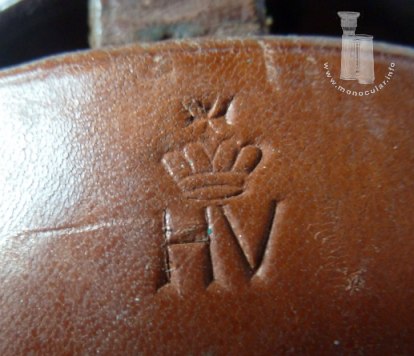
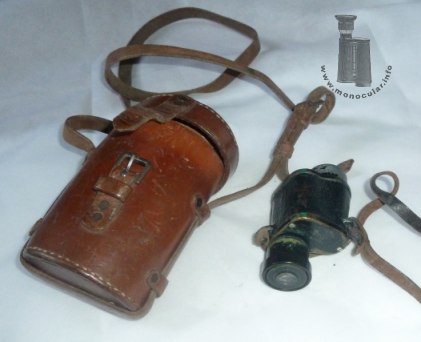
Fotos: Zeun; 1-4 Ebay

